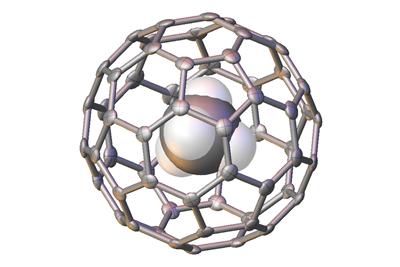Scientists’ molecular surgery yields methane ‘buckyball’ breakthrough

Researchers at the University of Southampton have successfully placed methane within a ‘buckyball’ molecular cage, making it the first organic molecule to be entrapped in the chemical procedure.
Collaborative research within the School of Chemistry used a controlled series of chemical reactions to unzip and re-stitch the spherical Buckminsterfullerene molecule, or buckyball, to complete the first synthesis and characterisation of CH4@C60.
The breakthrough opens up new possibilities for studying the physical properties of molecules and could help speed the development of improved medical imaging techniques.
Scientists published their findings in February’s edition of Angewandte Chemie, a journal of the German Chemical Society.
A buckyball is a cage of 60 carbon atoms that can be used to observe the behaviour of an entrapped molecule in a unique, isolated environment. The Whitby Group at Southampton employs a chemical method to open up a hole in the cage suitable for a single molecule such as helium or water to enter, before a special sealing procedure re-forms an intact C60 shell.
Research Fellow Dr Sally Bloodworth, a co-author of the latest study, explains: “We have developed conditions for suturing a large hole in C60 – one which is big enough to allow entry of a greater range of atoms and molecules than has been possible previously. Our conditions involve the use of monochromatic yellow light to induce a ring-contraction which, in a key step, makes the large hole smaller, and prevents escape of the inserted molecule. Methane (CH4) is the biggest molecule to have been entrapped in C60 and represents the upper limit of what can be accommodated in the cavity.”
The CH4@C60 synthesis was led by Professor Richard Whitby and Professor Malcolm Levitt as part of two research projects funded by the Engineering and Physical Sciences Research Council.
“Our new material will enable Southampton researchers and international collaborators to study the physical properties of an isolated methane molecule for the first time, using spectroscopic methods including Nuclear Magnetic Resonance (NMR) Spectroscopy,” Sally says. “These molecules also have potential application in a process called ‘hyperpolarisation’, developed by the Levitt Group, which is capable of enormously enhanced signals in NMR techniques such as MRI (Magnetic Resonance Imaging).
“Our new method to suture the very large hole in C60 could also be applied to the synthesis of other materials where C60 contains a large molecule. It is known that the hole is large enough to accommodate oxygen, methanol, and ammonia, and greater study of these molecules can enhance their role in the development of improved imaging techniques.”